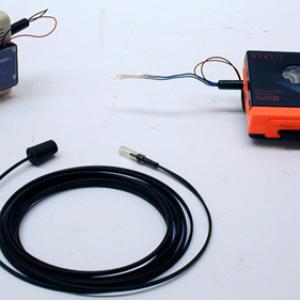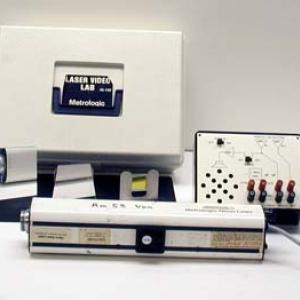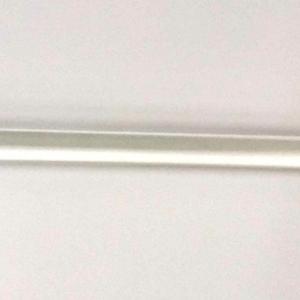College of Liberal Arts & Sciences
6A01.25 - Audio/Video Communications - Optical Method
Plug the LED into the portable tape player and connect the battery pack. Then also plug the photocell into the Radio Shack speaker amplifier. The modulated light signal given off by the tape player can be picked up with the photocell.
Plug the earphone jack of the radio or the wave generator into the modulated laser. Caution should be observed that an amplified signal is not put into the laser as anything above 1 volt peak to peak will burn out the modulating transistors in the laser. Also note that the laser can only be modulated to frequencies of 1 MHz. without severe distortion. Plug either the photovoltaic cell or the LSR into the homemade pre-amp and plug the pre-amp into a speaker. Focus the laser beam onto the detector that you have chosen. Sound should now be transmitted via laser beam to the pre-amp/speaker assembly.
The modulated laser may be replaced with the portable tape player and the LED and battery assembly. The batteries light the LED and by plugging into the earphone jack of the tape player you modulate the LED output. This signal may be picked up by either the LSR or the photovoltaic cell in the same manner as the laser setup. A fiber optics cable may be used transmit the LED signal to the photocell or LSR.
- Christopher Chiaverina, "The Versatile Constant Velocity Car", TPT, Vol. 58, #7, Oct. 2020, p. 524.
- Chris Chiaverina, "Dollar Store Lightwave Communications System", TPT, Vol. 53, #9, Dec. 2015, p. 566.
- James M. Moses, K. P. Trout, "A Simple Laser Microphone for Classroom Demonstration", TPT, Vol. 44, # 9, Dec. 2006, p. 600.
- David Keeports, "Estimating the Speed of Light from a Satellite Echo", TPT, Vol. 42, #3, Mar. 2004, p.154.
- Adam Niculescu, "Demonstration of Light-Wave Communication for High School Physics", TPT, Vol. 40, #6, Sept. 2002, p. 347.
- Dames J. Boire, "How To Modulate a Pointer Laser", TPT, Vol. 33, #1, Jan. 1995, p. 58.
- John W. Jewett, "Get The LED Out", TPT, Vol. 29, #8, Nov. 1991, p. 530.
- Barbara S. Andereck, "Microwave Hot Spots",TPT, Vol. 28, #9, Dec. 1990, p. 580.
- John M. Pitre, Paul Sharpe, and Richard Tasgal, "Lightwave Communication Apparatus for the Classroom", TPT, Vol. 28, #8, Nov. 1990, p. 560.
- Govind P. Agrawal, "Semiconductor Lasers and their Application in Optical Fiber Communication", TPT, Vol. 23, #8, Nov. 1985, p. 478.
- Henry Levinstein, "The Physics of Toys", TPT, Vol. 20, #6, Sept. 1982, p. 358, also a Potpourri of Physics Teaching Ideas - Toys, p. 269.
- Barry N. Lightfoot, "Laser Communicator", TPT, Vol. 19, #5, May 1981, p. 343.
- Thomas B. Greenslade, Jr., "The Photophone", TPT, Vol. 17, #6, Sept. 1979, p. 382.
- J. B. van der Kooi, "Transmitting Sound by Light", TPT, Vol. 17, #1, Jan. 1979, p. 43.
- Matt Young, "Optical Communications", TPT, Vol. 11, #6, Sept. 1973, p. 365.
- William M. Zeitz and Terrence P. Toepker, "Sound of a Light Beam", TPT, Vol. 7, #5, May 1969, p. 301.
- Seung Koo Lee, Deok In Kim, Gee Na Kim, and D. Cho, "Voice Transmission via Frequency-Modulated Diode Laser Light", AJP, Vol. 74, #11, Nov. 2006, p. 1037.
- J. A. Deblaquiere, K. C. Harvey, and A. K. Hemann, "Time-of-Flight Measurement of the Speed of Light Using an Acousto-Optic Modulator", AJP, Vol. 59, #5, May 1991, p. 443.
- Joel Solomon and Robert Prigo, "Eavesdropping with a Laser", AJP, Vol. 55, #4, Apr. 1987, p. 381.
- A. Selvarajan, B. S. Ramakrishna, "Laser Communication System Using The Ultrasonic Light Modulator", AJP, Vol. 47, #3, March 1979, p. 282.
- David K. Hsu, "Positional Modulation in Laser Communication", AJP, Vol. 45, #11, Nov. 1977, p. 1127.
- James S. Vinson, Vasilis Kostakis, "Inexpensive Laser Communication Apparatus", AJP, Vol. 44, #1, Jan. 1976, p. 111.
- Antonio Armando Carrá, "Simple Arrangement for Internal Audiomodulation of a He-Ne Laser", AJP, Vol. 38, #7, July 1970, p. 926.
- Jonathan Hare, "How to Communicate in a Vacuum", Physics Education, Vol. 39, #3, May 2004, p. 242.
- Don Rathjen and Paul Doherty, "Modulated LED", Square Wheels, 2002, p. 51.
- T. Kallard, "Voice and TV Picture Transmission Over a Laser Beam", Exploring Laser Light, p. 73.
- Mark Davids, et al., "A Fiber Photophone", Teaching about Lightwave Communications, 1994, p. 3-23.
- Mark Davids, et al., "Light Signals From A Radio", Teaching about Lightwave Communications, 1994, p. 3-11.
- Mark Davids, et al., "An LED Photophone", Teaching about Lightwave Communications, 1994, p. 3-11.
- Mark Davids, et al., "A Grain of Wheat Photophone", Teaching about Lightwave Communications, 1994, p. 3-10.
- Yaakov Kraftmakher, "7.12 Optical Communication", Experiments and Demonstrations in Physics, ISBN 981-256-602-3, p. 477.
- Yaakov Kraftmakher, "4.3 Optical Communication", Experiments and Demonstrations in Physics, ISBN 981-256-602-3, p. 237.
- Simon Quellen Field, "A Simple Laser Communicator", Gonzo Gizmos, p. 169 - 176.
- Gordon McComb, "Electronic Modulation of Helium-Neon Lasers", Lasers, Ray Guns, & Light Cannons, p. 197.
- Gordon McComb, "Acoustic Modulation", Lasers, Ray Guns, & Light Cannons, p. 194.
- "Modulated Laser", Science Snackbook, p. 67.1 - 67.4.
- Robert E. Iannini, "Voice Modulation of a He-Ne Laser (HNM1)", Build Your Own Working Fiber Optics, Infrared and Laser Space-Age Projects, p. 91 - 95.
- Jim Overhiser and Luat Vuong, "Communicating with Light: From Telephony to Cell Phone", CNS Institute for Physics Teachers, June 2010.
- Chuck Britton, "Optical Communications Demonstration", PIRA News, Vol. 6, #2, Oct. 1991.
- Curt Suplee, "Making Light Speak", Everyday Science Explained, National Geographic, p. 118.
- Forrest M. Mims III, "LED Transmitter / Receiver", Vol. IV - Electronic Formulas, Symbols & Circuits, p. 129.
Disclaimer: These demonstrations are provided only for illustrative use by persons affiliated with The University of Iowa and only under the direction of a trained instructor or physicist. The University of Iowa is not responsible for demonstrations performed by those using their own equipment or who choose to use this reference material for their own purpose. The demonstrations included here are within the public domain and can be found in materials contained in libraries, bookstores, and through electronic sources. Performing all or any portion of any of these demonstrations, with or without revisions not depicted here entails inherent risks. These risks include, without limitation, bodily injury (and possibly death), including risks to health that may be temporary or permanent and that may exacerbate a pre-existing medical condition; and property loss or damage. Anyone performing any part of these demonstrations, even with revisions, knowingly and voluntarily assumes all risks associated with them.


